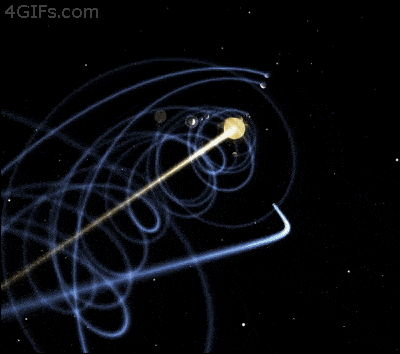The Milky Way is MOVING through the universe at 2.1 MILLION kilometers per hour
By
Nothing is stationary. As you are reading this, the Earth revolves around its own axis; it orbits the sun, the sun moves through space at a staggering 792,000 kilometers per hour around the galactic center, and our universe moves at a mind-bending 2.1 million kilometers per hour.
You may think that as you are reading this, you are in a stationary position and not moving. However, everything within the universe moves, from our planet –which rotates on its axis at a speed of nearly 1700 kilometers per hour— to the solar system and even the galaxy.
The planets in the solar system and their respective moons also move through space. In fact, in order to keep us in a stable orbit, Earth needs to move around 30 kilometers per second. The inner planets in our system, Mercury and Venus move faster while Mars and the outer planets of our solar system soar through space at a slower pace.
But think bigger. Even though the Sun is at the center of our solar system, it is also moving at an incredible speed through space. If we think even bigger, we will realize that even our Milky Way galaxy is in motion, and all remaining things that make up the universe such as stars, planets, gas clouds, black holes and even dark matter move within the universe.
Just as Earth orbits the Sun, our Sun orbits the galactic center –which from our vantage point is located around 25,00 light years— in an elliptic orbit. It completes a revolution every 225 million years approximately. This is called a Galactic year.
It is estimated that since the Sun and Earth formed, 20 galactic years have passed, meaning that we completed 20 successful revolutions around the galactic center. However, if we compare recorded human history to our movement across the universe, we would realize we barely moved in our galactic pathway.
But what about Speed? In order to complete a successful revolution around the galactic center, the Sun has to move at a staggering 792,000 kilometers per hour. The Earth –and all other objects in our solar system— follow the sun at this fanatic speed.
In comparison, light travels at a fascinating speed of 1.09 BILLION kilometers per hour.
However, not only do planets, moons, and in this case, our sun move through space, the galaxy too moves through space, affected by the gravitation of other massive objects in the universe.
As it turns out, our Galaxy is currently being catapulted –by other galaxies and clusters in the vicinity— towards a certain point in the universe.
But hold on a minute, compared to WHAT are we actually measuring the motion through the universe? Well, when discussing our speed around the galaxy, scientists are able to measure it relative to the CENTER of the Milky Way.
Image credit: NASA, ESA, and A. Feild (STScI), via http://www.spacetelescope.org/images/heic0805c/.
However, the Milky way isn’t stationary, and it also moves. So what can you compare its motion to?
For a long time, astronomers were not able to answer this. We can compare our galaxy’s speed with another galaxy, but all other galaxies move through the universe just as the Milky way.
In order to answer this enigma, scientists point towards the Big Bang and CBR—Cosmic Background Radiation.
As noted by NASA, The Big Bang theory predicts that the early universe was a very hot place and that as it expands, the gas within it cools. Thus the universe should be filled with radiation that is literally the remnant heat left over from the Big Bang, called the “cosmic microwave background,” or CMB. The CMB radiation was emitted 13.7 billion years ago.
Technically speaking, the CBR offers experts with a frame of reference for the universe, relative to which we can calculate our motion.
In order to get an idea of how fast we move through the universe, experts need to subtract the motion of the Earth around the Sun and the Sun around the center of the Milky Way from the motion measured compared to the CBR.
This means that the Milky Galaxy is speeding through space at an astonishing 2.1 million kilometers per hour, in the direction of the constellations of Leo and Virgo; precisely where the so-called Great Attractor is located.
Reference:
Featured image by DjSadhu.com
Source: https://www.ancient-code.com/



No comments:
Post a Comment